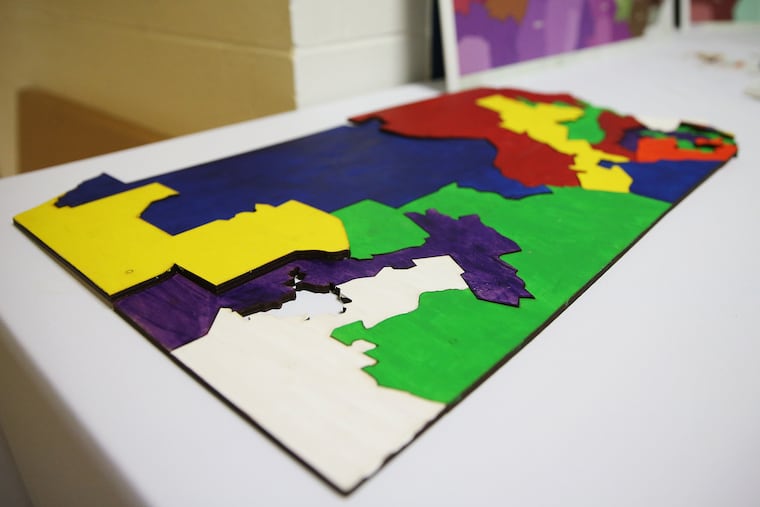Lawmakers' power to redraw Pa.'s political maps could be more limited in 2021
A bill advancing in the state Senate would set strict criteria for drawing congressional and legislative maps, and make underlying data available for analysis.

Spotlight PA is an independent, nonpartisan newsroom powered by The Philadelphia Inquirer in partnership with PennLive/The Patriot-News, TribLIVE/Pittsburgh Tribune-Review, and WITF Public Media. Sign up for our free weekly newsletter.
HARRISBURG — Lawmakers are still in charge of drawing Pennsylvania’s political maps, but good-government advocates say a bill making its way through the state Senate would check the most egregious gerrymandering practices and boost public transparency when the process begins again next year.
The bill, sponsored by Sens. Tom Killion (R., Delaware) and Lisa Boscola (D., Northampton), would require lawmakers to hold public meetings, make underlying data available for analysis, and set strict criteria for drawing congressional and legislative maps.
Lawmakers, for example, would not be able to disregard county and city boundaries to pack voters into a single district — one of the problems the state Supreme Court identified in 2018, when it overturned and later redrew the state’s congressional map.
The measure advanced out of the State Government Committee on Tuesday with bipartisan, though not unanimous, support. If both the full House and Senate pass the bill before the end of the year, and Gov. Tom Wolf signs off, the new rules would be in place when lawmakers begin drawing the maps in 2021.
That’s a process that takes place every 10 years, after the completion of the census. State lawmakers are in charge of drawing a congressional map that must then be approved by the governor.
The state House and Senate maps, however, are drawn by a five-member commission made up of Democratic and Republican leaders from the legislature, as well as a chair picked by those lawmakers or, if they can’t agree, the Pennsylvania Supreme Court.
Grassroots and good-government groups have long wanted to take lawmakers completely out of the process and hand over the job to a committee of average citizens. Independent research has shown that gerrymandering — the process by which lawmakers concentrate one party’s voters into a single district or spread them out unnaturally — protects incumbents and strips residents of political power.
But bills to create a citizen-led commission have stalled in the General Assembly.
To make matters more complicated, changing how the legislative maps are drawn requires voters to approve a constitutional amendment — a lengthy process with strict deadlines that have since passed.
“The window of opportunity for such reform around who draws political districts is nearly closed,” David Thornburgh, president of the nonpartisan, good-government group Committee of Seventy, wrote in a letter to lawmakers Tuesday. “But there is still time to address the what and the how of redistricting, which can still significantly mitigate the risk of gerrymandering and bolster public trust in the process.”
The measure that advanced Tuesday is virtually identical to a bill in the House sponsored by Rep. Wendi Thomas (R., Bucks).
It would put in place criteria to strengthen long-standing requirements, like ensuring districts have an equal number of people. There would also be a cap on how many times lawmakers who draw the maps can split a county — a provision that would provide a check on the “most outrageous” gerrymanders, one legal expert previously told Spotlight PA.
The measure would also codify into law years-long efforts by grassroots groups like Fair Districts PA to make the redistricting process more transparent. Videos of meetings and the underlying data used to create or evaluate maps would be made available on a website, and public hearings would be held several times before and after lawmakers finalize the plans.
The chair of the committee, Sen. John DiSanto (R., Dauphin), said that the bill “provides the best opportunity for being the vehicle that can make it across the finish line” but that it may need additional changes.
“I believe there will need to be a compromise around some of the key provisions in the current bill that many find problematic, including ... insufficiently defined terms and arguably impractical and excessively cumbersome district drawing processes,” he said.
Lyndsay Kensinger, a spokesperson for Wolf, said the governor would review the measure and “make a decision on the bill if it reaches his desk.”
100% ESSENTIAL: Spotlight PA relies on funding from foundations and readers like you who are committed to accountability journalism that gets results. If you value this reporting, please give a gift today at spotlightpa.org/donate.